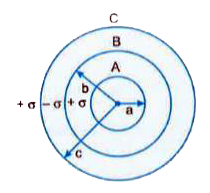Three concentric spherical shells have radii a,b and c(a<b<c) and have surface charge densities σ,−sigam and σ respectively. If VA,VB and VC denote the potentials of the three shells, then for c=q+b, we have
VC=VB≠VA
VC≠V≠VA
VC=VB=VA
VC=VA≠VB
The correct Answer is:D
VA=k(σ)(4πa2)a+k(−σ)4πb2b+(kσ4πc2/(c)
=4πkσ(a−b+c)

Similarly VB=4πkσ(a2b−b+c)
VC=4πkσ(a2c−b2c+c)
=4πkσ(a2−b2c+c)
=4πkσ((a+b)(a−b)c+c)
=4πkσ[(a−b)+c]
=4πkσ(a−b+c)
So, VA=VC≠VB
Topper's Solved these Questions
- ELECTROSTATIC POTENTIAL AND CAPACITANCEBOOK - PHYSICS WALLAHCHAPTER - ELECTROSTATIC POTENTIAL AND CAPACITANCEEXERCISE - LEVEL II
34 Videos
- ELECTROSTATIC POTENTIAL AND CAPACITANCEBOOK - PHYSICS WALLAHCHAPTER - ELECTROSTATIC POTENTIAL AND CAPACITANCEEXERCISE - NEET Past 5 Years Questions
15 Videos
- ELECTROMAGNETIC WAVESBOOK - PHYSICS WALLAHCHAPTER - ELECTROMAGNETIC WAVESEXERCISE - NEET Past 5 Years Questions
8 Videos
- GENERAL PRINCIPLES AND PROCESSES OF ISOLATION OF ELEMENTSBOOK - PHYSICS WALLAHCHAPTER - GENERAL PRINCIPLES AND PROCESSES OF ISOLATION OF ELEMENTSEXERCISE - NEET Past 5 Years Questions
14 Videos
Similar Questions
Three concentric spherical metallic shells A,B,andC of radii a,b,andc(a<b<c) have surface charge densities σ,−σ and σ, respectively.
If VA,VB and VC are potential of shells A, B and C, respectively, match the columns
Column AColumn Ba.VAi.σε0[a2−b2+c2c]b.VBii.σ2ε0[a2b−b+c]c.VCiii.σε0[a−b+c]
View SolutionThree concentric spherical metallic shells A, B and C of radii a, b and c (a lt b ltc) have surface charge densities σ, −σ and σ respectively.
(i) Find the potential of the three shells A, B and C.
(ii) If the shells A and C are at the same potential, obtain the relation between the radii a, b and c.
View Solution
Knowledge Check
Three concentric spherical shells have radii a,b and c(a<b<c) and have surface charge densities σ,−sigam and σ respectively. If VA,VB and VC denote the potentials of the three shells, then for c=q+b, we have
AVC=VB≠VABVC≠V≠VACVC=VB=VADVC=VA≠VBThree concentric spherical shells have radii a,b and c(a<b<c) and have surface charge densities σ,−σandσ respectively. If VA,VB and VC denote the potentials of the three shells, then for c=a+b, we have
AVC=VA≠VBBVC=VB≠VACVC≠VB≠VADVC=VB=VAThree concentric spherical shells have radii a,b and c(a<b<c) and have surface charge densities σ,−σ and σ respectively. If VA,vB and Vc denote the potentials of the three shells, then, for VA=VC, we get-
Ac=a+b2Bc=b−aCc=2(a+b)Dc=a+b
Three concentric metallic shells A, B and C of radii a, b and c(a<b<c) have surface charge densities +σ,−σand+σ respectively as shown. Obtain the expressions for the potential of three shells A, B and C. If shells A and C are at the same potential, obtain the relation between a, b and c.

View SolutionThree concentric metallic shells A , B and C of radii a, b and c (a<b<c) have surface densities +σ,−σ and +σ respectively as shown in Fig.

Obtain the expressions for the potential of three shells A , B and C .
View SolutionThree concentric spherical metallic shells A, B and C of radii a, b and c (a lt b ltc) have surface charge densities σ, −σ and σ respectively.
(i) Find the potential of the three shells A, B and C.
(ii) If the shells A and C are at the same potential, obtain the relation between the radii a, b and c.
View SolutionThree concentric spherical metallic spheres A,B and C of radii a,b and c(a<b<c) have surface charge densities σ,−σ and σ respectively.
View SolutionThree concentric metallic spherical shells A,B and C of radii a,band c(a<b<c) have surface charge densities −σ,+σand -sigma respectively,thepotentialofshellA is
View Solution
